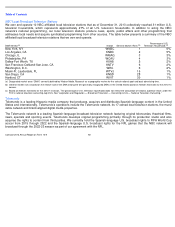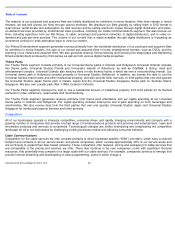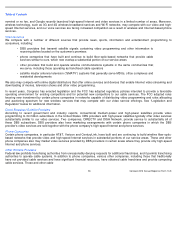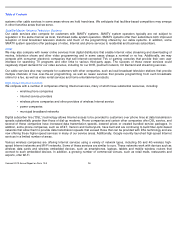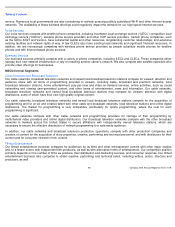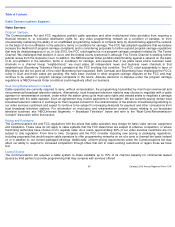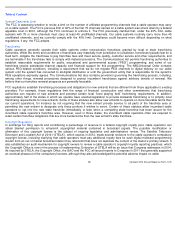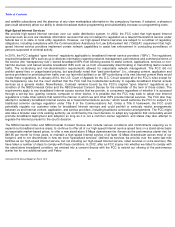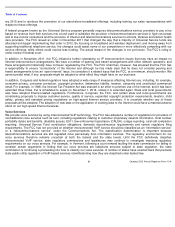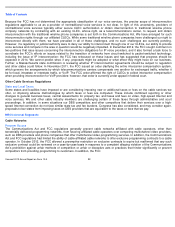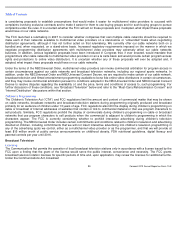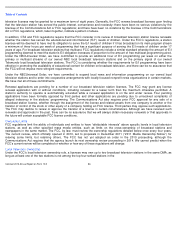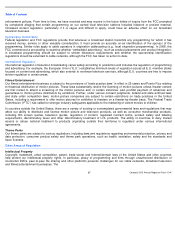Comcast 2013 Annual Report Download - page 25
Download and view the complete annual report
Please find page 25 of the 2013 Comcast annual report below. You can navigate through the pages in the report by either clicking on the pages listed below, or by using the keyword search tool below to find specific information within the annual report.
Table of Contents
and satellite subscribers and the absence of any clear marketplace alternative to the compulsory licenses. If adopted, a phaseout
plan could adversely affect our ability to obtain broadcast station programming and substantially increase our programming costs.
High-Speed Internet Services
We provide high-speed Internet services over our cable distribution system. In 2002, the FCC ruled that high-
speed Internet
services such as ours are interstate information services that are not subject to regulation as a telecommunications service under
federal law or to state or local utility regulation. However, our high-
speed Internet services are subject to a number of regulatory
obligations, including compliance with the Communications Assistance for Law Enforcement Act (“CALEA”) requirement that high-
speed Internet service providers implement certain network capabilities to assist law enforcement in conducting surveillance of
persons suspected of criminal activity.
In 2010, the FCC adopted “open Internet” regulations applicable to broadband Internet service providers (“ISPs”).
The regulations
required broadband ISPs such as us to disclose information regarding network management, performance and commercial terms of
the service (the “transparency rule”); barred broadband ISPs from blocking access to lawful content, applications, services or non-
harmful devices; and barred wireline broadband ISPs such as us from unreasonably discriminating in transmitting lawful network
traffic. The no-blocking and non-
discrimination requirements allowed for reasonable network management. The FCC did not
prohibit speed tiers or usage-based pricing, but specifically noted that “paid prioritization” (
i.e., charging content, application and
service providers for prioritizing their traffic over our last-mile facilities) or an ISP’
s prioritizing of its own Internet content likely would
violate these regulations. In January 2014, the U.S. Court of Appeals for the D.C. Circuit vacated all of the FCC’
s rules except for
the transparency rule but the court clarified that the FCC had the fundamental authority to regulate broadband Internet access
services as a general matter. Nevertheless, Comcast remains bound by the FCC’s original “open Internet”
regulations as a
condition of the NBCUniversal Order and the NBCUniversal Consent Decree for the remainder of the term of those orders. The
requirements apply to any broadband Internet access service that we provide, to consumers regardless of whether it is accessed
through a set-
top box, gaming console, computer or other device. It is possible that the FCC may seek to adopt new Internet
regulations or take other actions that restrict the manner in which we and other ISPs provide Internet services. The FCC also may
attempt to reclassify broadband Internet service as a “telecommunications service,”
which would authorize the FCC to subject it to
traditional common carriage regulation under Title II of the Communications Act. Under a Title II framework, the FCC could
potentially regulate our customer rates for broadband Internet services and could prohibit or seriously restrict arrangements
between us and Internet content, application, and service providers, including backbone connection arrangements. The FCC might
also take a broader view of its existing authority, as confirmed by the court decision, to adopt any regulation that conceivably would
promote broadband deployment and adoption so long as it is not a common carrier regulation, and states may also attempt to
regulate the Internet pursuant to the court’s decision.
The NBCUniversal Order and NBCUniversal Consent Decree also include various conditions and commitments requiring us to
expand our broadband service areas, to continue to offer all of our high-speed Internet service speed tiers on a stand-
alone basis
at reasonable market-based prices, to offer a new stand-
alone 6 Mbps downstream tier (known as the performance starter tier) for
$49.95 per month for three years, to maintain a high-
speed Internet service of at least 12 Mbps downstream across most of our
footprint, and to not discriminate in how we treat “specialized services” (defined as services we provide over the same last-
mile
facilities as our high-speed Internet service, but not including our high-
speed Internet service, video services or voice services). We
have taken a number of steps to comply with these conditions. In 2012, after an FCC inquiry into whether we failed to comply with
the stand-
alone broadband condition, we entered into a consent decree with the FCC to extend our offering of the performance
starter tier for one additional year until Febru-
Comcast 2013 Annual Report on Form 10
-
K
20


